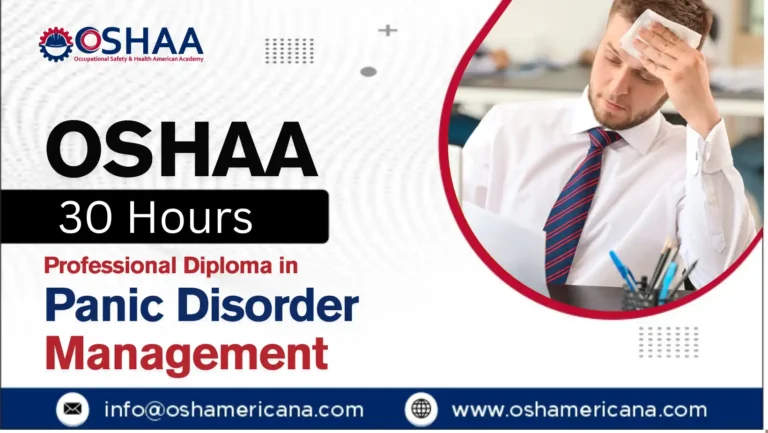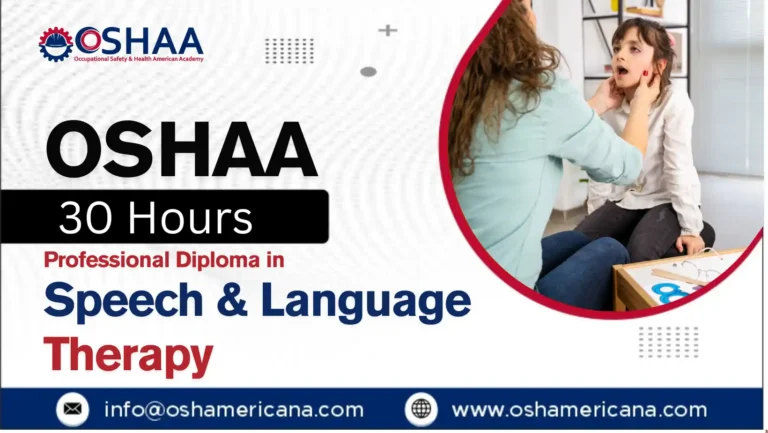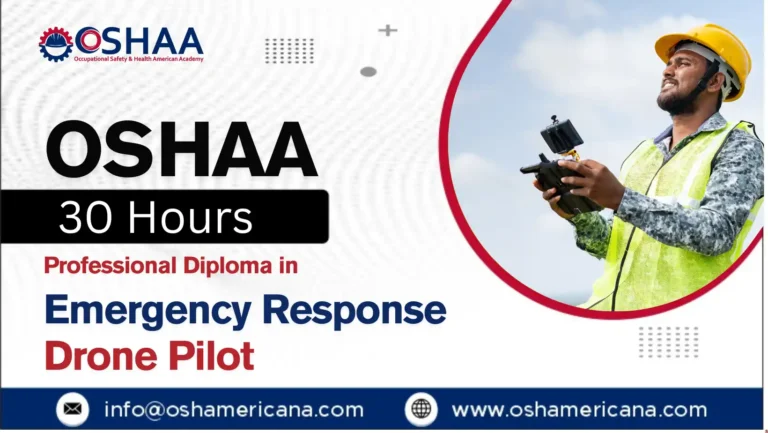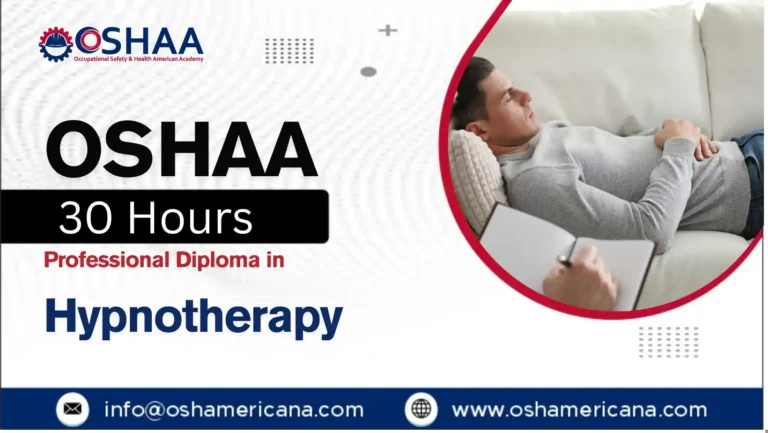The OSHAA 30-Hours Professional Diploma in CPR and AED provides comprehensive life-saving training, equipping professionals to respond effectively in medical emergencies.
The OSHAA 30-Hours Professional Diploma in CPR and AED is an advanced, internationally recognized training program designed to equip individuals with essential life-saving skills required to respond confidently and effectively during medical emergencies. In today’s fast-paced and unpredictable world, the ability to perform cardiopulmonary resuscitation (CPR) and operate an automated external defibrillator (AED) can make the difference between life and death. This professional diploma offers a structured, in-depth learning experience that empowers participants to take immediate, appropriate action in emergency situations, whether at work, in public places, or within the community.
The OSHAA 30-Hours Professional Diploma in CPR and AED focuses on developing both theoretical understanding and hands-on competence in emergency response. Participants learn the critical steps of CPR, including chest compressions, rescue breathing, and the correct use of an AED device, ensuring that they can intervene effectively until professional medical help arrives. This course also covers essential topics such as recognizing cardiac arrest, maintaining scene safety, assessing patient responsiveness, and ensuring compliance with internationally recognized first aid and emergency care standards. By integrating practical simulations and real-world case scenarios, the program ensures that learners not only acquire technical knowledge but also build the confidence to apply it in high-pressure environments.
Professionals working in high-risk sectors such as healthcare, construction, education, manufacturing, and hospitality will greatly benefit from completing the OSHAA 30-Hours Professional Diploma in CPR and AED. This qualification is particularly valuable for first aid officers, safety coordinators, supervisors, and any personnel responsible for workplace health and safety. Organizations that prioritize this training not only enhance their emergency preparedness but also demonstrate a commitment to the well-being of their employees and the general public. In addition, compliance with OSHAA standards and other international safety regulations helps businesses maintain a safe working environment and minimize legal risks associated with workplace accidents or emergencies.
The OSHAA 30-Hours Professional Diploma in CPR and AED goes beyond traditional first aid training by providing participants with advanced emergency response capabilities. It emphasizes the importance of timely intervention in cardiac emergencies, where every second counts. Through this course, learners gain a thorough understanding of the physiological aspects of cardiac arrest and resuscitation, as well as the operation and maintenance of AED devices. This combination of medical insight and practical ability ensures that participants can confidently take control of emergency situations, potentially saving lives both inside and outside the workplace.
Furthermore, the OSHAA 30-Hours Professional Diploma in CPR and AED supports career development and professional growth across industries. Individuals who complete this training demonstrate a high level of responsibility, awareness, and commitment to safety, which are qualities highly valued by employers worldwide. In addition, organizations benefit from having certified personnel capable of responding swiftly and effectively to emergencies, thereby improving overall safety culture, reducing incident severity, and fostering a more resilient workforce.
Incorporating this program into workplace safety initiatives enhances compliance with global occupational health and safety frameworks while promoting a proactive approach to emergency management. The OSHAA 30-Hours Professional Diploma in CPR and AED ensures that participants not only meet industry standards but exceed them, contributing to safer environments and stronger communities.
By completing the OSHAA 30-Hours Professional Diploma in CPR and AED, individuals gain the expertise, confidence, and certification required to act decisively during critical moments. This comprehensive training prepares participants to safeguard lives, support organizational safety goals, and uphold international standards of care. Whether for personal development, professional advancement, or regulatory compliance, this qualification represents an invaluable investment in safety, readiness, and human well-being.
OSHAA 30-Hours Professional Diploma in CPR and AED
To enroll in the OSHAA 30-Hours Professional Diploma in CPR and AED, learners are expected to meet the following criteria:
1. Age Requirement
- Applicants must be at least 18 years of age to register for the OSHAA 30-Hours Professional Diploma in CPR and AED, ensuring they possess the maturity and responsibility required for professional first aid and emergency response training.
- This minimum age requirement aligns with OSHAA’s international safety and compliance standards, promoting a professional learning environment suitable for adult learners.
- Participants under 18 may be considered in special cases where prior safety or healthcare training has been completed, subject to approval by the training provider.
2. Educational Background
- To enroll in the OSHAA 30-Hours Professional Diploma in CPR and AED, learners should have completed at least secondary education or an equivalent qualification.
- A background in health sciences, safety management, or workplace supervision is considered an advantage, though it is not mandatory for admission.
- The course is designed to accommodate learners from diverse educational and professional backgrounds, ensuring accessibility for individuals seeking to gain internationally recognized emergency response and life-saving skills.
- Those with higher education in related fields such as nursing, healthcare, or occupational safety may benefit from an enhanced understanding of the technical and procedural elements of CPR and AED application.
3. Work Experience
- Prior work experience is not a strict requirement for admission into the OSHAA 30-Hours Professional Diploma in CPR and AED. However, candidates currently employed in sectors such as healthcare, construction, education, hospitality, or industrial operations will find the training especially relevant and practical.
- Individuals in safety-related roles or those aspiring to become certified first responders can significantly enhance their professional competence and career advancement through this qualification.
- The OSHAA 30-Hours Professional Diploma in CPR and AED provides comprehensive training suitable for both new learners and experienced professionals seeking to refresh or upgrade their first aid and emergency response skills.
- The program is structured to deliver real-world applications of CPR and AED use in diverse workplace settings, making it a valuable addition for both entry-level and experienced personnel.
4. English Proficiency
- Since the OSHAA 30-Hours Professional Diploma in CPR and AED involves detailed instructional materials, safety terminology, and international compliance content, learners must possess adequate English language proficiency.
- Participants should be able to read, write, and speak English fluently to ensure full comprehension of the course materials, safety procedures, and assessment requirements.
- English proficiency ensures that learners can effectively interpret CPR and AED operational guidelines, emergency protocols, and regulatory documentation.
- Those who meet the language requirement will be better equipped to communicate clearly in real emergency scenarios and adhere to global first aid and safety standards.
Meeting these eligibility requirements ensures that all participants in the OSHAA 30-Hours Professional Diploma in CPR and AED are prepared to engage fully with the course content, apply life-saving techniques confidently, and comply with OSHAA’s international training and safety standards. This comprehensive qualification is designed to support individuals and organizations in achieving higher levels of preparedness, professionalism, and compliance within emergency response and workplace safety frameworks.
Study Units
Learning Outcomes
Introduction to CPR and AED (2 Hours)
- Understand the importance of CPR and AED in saving lives.
- Recognise the signs of cardiac emergencies such as heart attacks and strokes.
- Learn the legal and ethical responsibilities of a first responder.
- Understand the role of a rescuer in emergency situations.
- Gain basic knowledge of when and how to use CPR and AED effectively.
Basic Life Support (BLS) – Adult and Child (5 Hours)
- Master CPR techniques for adults, including chest compressions and rescue breaths.
- Demonstrate CPR techniques for children (1-8 years) with modifications for their size and development.
- Perform infant CPR with correct compression and ventilation ratios.
- Learn airway management techniques to clear obstructed airways effectively.
- Understand the correct compression-to-ventilation ratios for different age groups.
- Develop confidence in performing CPR in high-stress emergency situations.
AED Use and Defibrillation (4 Hours)
- Understand the function and operation of an Automated External Defibrillator (AED).
- Learn when and how to apply an AED in cases of sudden cardiac arrest.
- Demonstrate proper electrode placement and use of the AED.
- Understand safety protocols when using AED, including recognising when to defibrillate and when not to.
- Practice using the AED in simulated emergency scenarios.
- Gain the ability to provide immediate post-defibrillation care.
Advanced Cardiac Life Support (ACLS) for Laypersons (4 Hours)
- Understand the principles of ACLS for non-medical professionals.
- Learn how CPR and AED integrate with ACLS protocols in the chain of survival.
- Gain an understanding of basic advanced airway management techniques.
- Learn how to recognise and respond to life-threatening arrhythmias and cardiac events.
- Practice team-based emergency response techniques to enhance collaborative efforts in ACLS scenarios.
First Aid for Medical Emergencies (6 Hours)
- Understand the basic principles of first aid and its role in emergency medical care.
- Master techniques for managing severe bleeding, including applying pressure and using bandages.
- Learn how to treat and manage fractures, sprains, and dislocations.
- Develop skills for handling burns, cuts, and abrasions.
- Learn how to identify and manage shock, including its symptoms and treatment options.
- Practice first aid techniques in simulated emergency situations, including choking, bleeding, and trauma care.
Special Considerations for High-Risk Populations (4 Hours)
- Understand the specific challenges of performing CPR and first aid on elderly individuals.
- Learn how to modify CPR techniques for pregnant women and ensure safety for both mother and child.
- Identify the unique considerations when performing CPR on obese individuals.
- Understand the appropriate adjustments for water-related emergencies, such as drowning.
- Gain hands-on experience in responding to emergencies involving high-risk populations through role-playing scenarios.
Workplace Safety and Emergency Response Protocols (5 Hours)
- Learn how to develop and implement an effective emergency response plan in the workplace.
- Understand workplace safety standards and regulations relevant to CPR, AED use, and first aid.
- Gain knowledge on coordinating emergency response efforts with co-workers and external services.
- Learn trauma management and how to respond to head, neck, and spinal injuries in the workplace.
- Develop team-based emergency response skills and practice through role-playing realistic workplace scenarios.
The OSHAA 30-Hours Professional Diploma in CPR and AED offers a wide range of benefits for individuals and organizations committed to improving health, safety, and emergency preparedness. This globally recognized qualification enhances participants’ ability to respond effectively during life-threatening situations, ensuring compliance with international safety standards and OSHA-aligned guidelines. Designed for professionals across industries such as healthcare, construction, education, and manufacturing, this course equips learners with practical knowledge, technical competence, and confidence to perform cardiopulmonary resuscitation (CPR) and use automated external defibrillators (AED) in real-world emergencies. Through its structured training approach, the OSHAA 30-Hours Professional Diploma in CPR and AED supports professional development, risk management, and the creation of safer workplaces worldwide.
1. Enhanced Life-Saving Skills
- The OSHAA 30-Hours Professional Diploma in CPR and AED equips learners with essential first aid, CPR, and AED operation skills, enabling them to respond swiftly and effectively to medical emergencies.
- Participants gain practical experience through realistic simulations that prepare them to handle cardiac arrest, respiratory distress, and sudden collapse with confidence.
2. Global Recognition and Certification
- This internationally recognized qualification enhances professional credibility and demonstrates commitment to workplace safety and health.
- The OSHAA 30-Hours Professional Diploma in CPR and AED is aligned with global OSHA standards, ensuring participants meet the highest levels of compliance and competence in emergency response.
3. Compliance with OSHA and International Safety Standards
- The course ensures that organizations and professionals comply with OSHA regulations and other global health and safety mandates.
- Completing the OSHAA 30-Hours Professional Diploma in CPR and AED reduces legal risks by maintaining full adherence to workplace safety requirements.
4. Improved Workplace Safety and Reduced Incidents
- By training employees in CPR and AED procedures, organizations significantly decrease the impact of workplace incidents.
- The OSHAA 30-Hours Professional Diploma in CPR and AED empowers teams to take immediate action, preventing fatalities and minimizing injury severity before medical professionals arrive.
5. Professional Development and Career Advancement
- The course enhances the professional profile of participants by providing a valuable safety credential recognized worldwide.
- The OSHAA 30-Hours Professional Diploma in CPR and AED opens opportunities for career growth in safety management, healthcare, and corporate compliance.
6. Confidence in Emergency Response
- Participants gain the confidence to perform life-saving actions under pressure, ensuring calm and effective responses during emergencies.
- The OSHAA 30-Hours Professional Diploma in CPR and AED provides structured training that transforms theoretical knowledge into practical competence.
7. Strengthened Organizational Reputation
- Companies that invest in the OSHAA 30-Hours Professional Diploma in CPR and AED demonstrate strong commitment to employee welfare and social responsibility.
- This commitment enhances brand image, trust, and stakeholder confidence by prioritizing safety and preparedness.
8. Cost-Effective Risk Management
- Training employees through the OSHAA 30-Hours Professional Diploma in CPR and AED reduces costs associated with workplace accidents, insurance claims, and compensation.
- A proactive approach to safety ensures long-term financial savings and operational continuity.
9. Enhanced Teamwork and Communication
- The course encourages collaboration and coordination among employees during emergency situations.
- The OSHAA 30-Hours Professional Diploma in CPR and AED fosters a culture of teamwork, where each member understands their role in ensuring safety and effective response.
10. Increased Productivity and Employee Well-Being
- A safe and well-prepared workforce contributes to higher morale and improved job satisfaction.
- Through the OSHAA 30-Hours Professional Diploma in CPR and AED, employees feel secure and valued, resulting in enhanced motivation and overall productivity.
11. Emergency Preparedness Across Industries
- The course is designed for professionals in healthcare, education, industrial, and corporate sectors, ensuring universal applicability.
- The OSHAA 30-Hours Professional Diploma in CPR and AED prepares participants to handle emergencies in any professional environment, from offices to remote work sites.
12. Legal and Regulatory Protection
- Completing the OSHAA 30-Hours Professional Diploma in CPR and AED helps organizations meet mandatory health and safety obligations.
- Properly trained employees can act within legal boundaries, protecting both the organization and individuals during emergency interventions.
13. Leadership and Safety Culture Development
- The course promotes safety leadership by training employees to take initiative in emergencies and promote preventive safety practices.
- The OSHAA 30-Hours Professional Diploma in CPR and AED builds a strong foundation for cultivating a proactive safety culture within organizations.
14. Improved Risk Awareness and Prevention
- Participants develop the ability to identify potential hazards and respond appropriately before situations escalate.
- The OSHAA 30-Hours Professional Diploma in CPR and AED teaches risk assessment, situational awareness, and preventive safety techniques applicable to all workplace settings.
15. Continuous Improvement and Lifelong Learning
- The training encourages continuous skill enhancement through regular updates and refresher modules.
- Graduates of the OSHAA 30-Hours Professional Diploma in CPR and AED remain equipped with up-to-date practices aligned with modern emergency response protocols and innovations in life-saving technologies.
By completing the OSHAA 30-Hours Professional Diploma in CPR and AED, individuals and organizations gain a powerful advantage in promoting workplace safety, compliance, and resilience. This globally respected certification not only saves lives but also supports long-term professional growth, organizational excellence, and adherence to OSHA-aligned international safety standards.
The OSHAA 30-Hours Professional Diploma in CPR and AED is specifically designed for individuals, professionals, and organizations committed to maintaining the highest standards of workplace safety, emergency preparedness, and health compliance. This globally recognized qualification is relevant for safety officers, healthcare professionals, educators, first responders, and corporate teams who aim to strengthen their emergency response capabilities. It supports OSHA compliance, enhances professional development, and promotes a culture of safety and life-saving awareness across industries. The OSHAA 30-Hours Professional Diploma in CPR and AED is an essential certification for those seeking to protect lives, improve organizational safety standards, and align with international health and safety regulations.
1. Safety Officers and HSE Professionals
- Responsible for implementing health and safety protocols, they require comprehensive CPR and AED training to ensure quick and effective responses during medical emergencies.
- The OSHAA 30-Hours Professional Diploma in CPR and AED enhances their ability to assess risks, coordinate emergency actions, and uphold OSHA-aligned standards.
- Learners gain practical life-saving skills critical for workplace incident management and employee protection.
- This qualification reinforces their professional credibility and supports ongoing compliance with occupational safety laws.
2. Healthcare Providers and Medical Staff
- Designed for nurses, paramedics, and clinic staff who are often the first responders during cardiac and respiratory emergencies.
- The OSHAA 30-Hours Professional Diploma in CPR and AED provides updated CPR techniques and AED usage guidelines aligned with international medical standards.
- Participants strengthen their emergency response efficiency in hospitals, clinics, and community health centers.
- The course supports professional development by adding a recognized life-saving certification to their medical portfolio.
3. School and Childcare Personnel
- Teachers, childcare providers, and school administrators play a vital role in ensuring the safety of students and young learners.
- Through the OSHAA 30-Hours Professional Diploma in CPR and AED, they gain the confidence to handle sudden cardiac or respiratory emergencies in educational environments.
- The training helps institutions meet health and safety requirements while protecting children and staff alike.
- This course promotes a proactive safety culture in schools, nurseries, and childcare centers.
4. Corporate and Office Employees
- Ideal for corporate staff, HR professionals, and management teams responsible for workplace wellness and safety.
- The OSHAA 30-Hours Professional Diploma in CPR and AED empowers them to take immediate action during cardiac incidents before medical help arrives.
- Participants develop key safety and communication skills to support emergency readiness programs.
- Organizations benefit from enhanced compliance, reduced response times, and improved employee confidence.
5. Construction and Industrial Workers
- Workers in high-risk industries such as construction, manufacturing, and oil and gas often face medical emergencies due to hazardous environments.
- The OSHAA 30-Hours Professional Diploma in CPR and AED equips them with the ability to deliver effective first aid and cardiac support in field conditions.
- This course aligns with OSHA and international safety standards, ensuring compliance during operations.
- Participants enhance their employability and value within safety-critical industries.
6. First Responders and Emergency Teams
- Essential for firefighters, police officers, rescue personnel, and disaster response units who require immediate life-saving intervention skills.
- The OSHAA 30-Hours Professional Diploma in CPR and AED ensures readiness for critical emergency scenarios where seconds determine survival.
- The program focuses on hands-on AED operation, CPR performance, and team coordination.
- Certification demonstrates advanced preparedness and professional competence under OSHA guidelines.
7. Hospitality and Tourism Professionals
- Hotel managers, flight attendants, and resort staff are responsible for guest safety and emergency management.
- The OSHAA 30-Hours Professional Diploma in CPR and AED equips them with the expertise to manage cardiac and respiratory emergencies among guests or coworkers.
- Participants gain practical knowledge applicable to high-traffic, customer-focused environments.
- This training enhances the organization’s reputation for safety and responsibility in the hospitality sector.
8. Sports Coaches, Fitness Trainers, and Recreation Staff
- Coaches, gym instructors, and sports facility managers often encounter physical exertion-related health emergencies.
- The OSHAA 30-Hours Professional Diploma in CPR and AED prepares them to respond swiftly to sudden cardiac arrest and ensure athlete safety.
- Participants learn risk prevention, early intervention, and the correct use of AEDs in fitness settings.
- The certification reinforces professionalism and adherence to international sports safety standards.
9. Community Volunteers and NGO Workers
- Ideal for individuals engaged in humanitarian work, community health programs, and volunteer emergency response initiatives.
- The OSHAA 30-Hours Professional Diploma in CPR and AED provides essential training for those who assist in disaster relief and public health missions.
- Learners gain confidence to administer CPR and use AEDs effectively in non-medical settings.
- The certification enhances public trust and readiness within community safety networks.
10. Employers, Supervisors, and Team Leaders
- Designed for business owners, operations managers, and team supervisors accountable for employee safety and compliance.
- The OSHAA 30-Hours Professional Diploma in CPR and AED helps them integrate effective emergency response training into workplace policies.
- Participants learn to lead emergency preparedness drills, improve risk management, and ensure workforce protection.
- Certification demonstrates leadership commitment to OSHA compliance and organizational resilience.
In conclusion, the OSHAA 30-Hours Professional Diploma in CPR and AED empowers professionals across all industries to take proactive steps in safeguarding lives and maintaining workplace safety excellence. This globally recognized qualification enhances emergency response capabilities, supports OSHA compliance, and fosters a culture of accountability, preparedness, and professional growth. By completing the OSHAA 30-Hours Professional Diploma in CPR and AED, participants strengthen their skills, elevate their career profiles, and contribute to safer, more responsive, and compliant workplaces worldwide.







